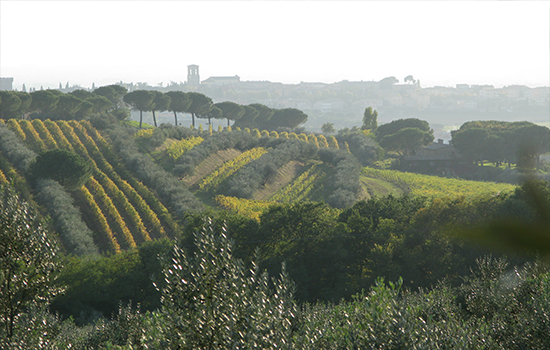Extra Virgin Olive Oil
THE HISTORY
Ever since the Etruscans introduced them to the farmlands of Umbria along with vines and wheat, olive trees have been an integral part of the Umbrian landscape, characterized by alternating areas of vines and of olive groves that produce one of the best extra virgin olive oils in Italy.
Anyone in this part of Italy who has a few “piantone” (the name used in dialect to refer to large olive trees) in their garden produces their own olive oil and the olive harvest is one of the highlights of the year; it is a joyous occasion to gather friends and family who brave the cold north autumn wind to lend a hand picking, in anticipation of the “reward”: toasted bread slices with just-pressed olive oil.
HARVEST
The varieties Frantoio, Leccino and Moraiolo, the typical cultivars of the Umbria Colli Martani DOP (Protected denomination of origin) appellation – which Torgiano falls under – are now harvested with shaker rakes or with shaker harvesters that safely grip the trunk and transmit vibrations causing the olives to detach; the fruit falls on nets laid on the ground under the trees and is picked up whole and then deposited into perforated crates about 1×1 metre (1×1 yard) in size and a maximum height of 50cm (20 inches), so that the olives on the bottom are not crushed by the weight of the ones on top.
Each evening of harvest the olives are delivered to a nearby olive mill where extraction takes place, at the latest 12 hours after picking. The olives come from approximately 12 hectares (almost 30 acres) of specialized olive groves; the trees pruned to monoconical shape are at an elevation between 250 and 300 meters above sea level (820-984 feet) on the Brufa hillside within the Torgiano estate while those with goblet pruning are at the Montefalco Estate at an elevation of 350 metres (almost 1150 feet). The microclimate of these two groves, both cultivated organically, confers intense aromas and flavour to the olives. The difference between the two oils – both of which are organic – which we produce from these olives (“DOP Umbria Colli Martani” and “Cantico”) stems from the harvest periods
As soon as the grape harvest has terminated, in mid-October, we begin harvesting the DOP Umbria Colli Martani, continuing until about early November: this early harvesting allows us to capture the emerald green colour and aromatic freshness of not-quite-mature olives to obtain a fruity and fragrant oil which is ideal when used raw; on the other hand, harvesting from mid- to end of November produces a more balanced oil with light fruitiness and extremely versatile in pairings: our “Cantico”. The harvest is generally completed by the end of November.
METHOD: FROM HARVESTING TO BOTTLING
Our olives are taken to a mill with the capability for batch processing, meaning that after each batch is processed the machine is washed; this avoids the risk of transferring any possible defects present in a given batch – caused by olives which arrived in non-optimal condition – to the subsequent batch.
The milling process is cold extraction in a continuous two-phase cycle using a centrifugal extractor by Pieralisi called “Leopard”, one of the most modern systems with outstanding performance currently in the industry.
Upon arriving at the mill the olives are de-leafed and washed to remove impurities but maintain the integrity of the fruit (called “drupes”). The subsequent crushing and malaxing are fundamental steps for the oil’s flavour and organoleptic characteristics because during this phase it is crucial to avoid oxidation and deterioration of the olive’s beneficial properties. State-of-the-art technology ensures optimal pressing during the extraction phase followed by highly efficient separation of the oil from its vegetable water and solid particles in a timely manner while also saving water and energy.
The new olive oil is then brought to Torgiano where it is stored in stainless steel vats topped up with nitrogen at controlled temperature to maintain its organoleptic and nutritional values intact; finally, after careful filtration, it is packaged into tins or bottles on the basis of purchase orders, so that the oil always remains fresh until the subsequent harvest.



